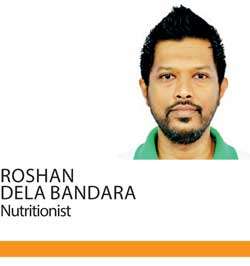Reply To:
Name - Reply Comment

Complementary feeding provides the child with nutrients like iron which are otherwise not obtained through mother’s milk
Milk is rich in protein, calcium and vitamins. Milk food groups contribute towards a body building function. Proteins are especially important in the growth stage
 Milk is a favourite refreshment, not to mention the nutritional values it carries. Milk is especially a favourite among children. From whole to skimmed, milk is available in many forms. However no form of milk is able to beat the nutritional goodness of mother’s breast milk. Mother’s milk plays a vital role regarding the growth of a child, specially during the first 6 months and even up to 2 years. However after the age of 2, milk is no longer adequate for the growth of a child. Roshan Dela Bandara, Nutritionist, Nutrition Society of Sri Lanka spoke about milk nutrition during infancy. He highlighted the importance of breastfeeding children during the first 2 years of infancy and fulfilling the additional nutritional requirements that follow.
Milk is a favourite refreshment, not to mention the nutritional values it carries. Milk is especially a favourite among children. From whole to skimmed, milk is available in many forms. However no form of milk is able to beat the nutritional goodness of mother’s breast milk. Mother’s milk plays a vital role regarding the growth of a child, specially during the first 6 months and even up to 2 years. However after the age of 2, milk is no longer adequate for the growth of a child. Roshan Dela Bandara, Nutritionist, Nutrition Society of Sri Lanka spoke about milk nutrition during infancy. He highlighted the importance of breastfeeding children during the first 2 years of infancy and fulfilling the additional nutritional requirements that follow.
Nourishment
“ From the time of birth, the baby should be exclusively breastfed for 6 months. At the start of the 7th month complementary feeding should be commenced alongside breast feeding. This should be continued up to the age of 2 years or more,” said Bandara. Referring to the WHO guidelines and Infant and Young children feeding guidelines for Sri Lanka, he stated that breastfeeding the child during the first 6 months after birth contributes towards the baby’s proper growth and provides the required immunity to fight against infections, develop the motor and cognitive functions. “Feeding infants with breast milk is advised for working mothers where the milk can be obtained and stored under refrigeration so that their babies are not deprived of the nutrition that breast milk provides,” the nutritionist informed stressing that proper support is needed from family and working places for this task. “ After 2 years of age breastfeeding is not necessary. By that time the child should be trained to eat usual family meals. The child should be given a balanced meal that adheres to the basic five food group category. Milk and milk products fall under one category. Therefore milk does not necessarily have to be given in liquid form after two years. The milk requirement can be satisfied through milk products such as cheese, curd and yoghurt etc,”Bandara continued.
According to the nutritionist, a meal has 3 vital aspects. They are the provision of energy for daily activities, supporting growth and development of the body and finally providing protection from disease. Energy is provided by carbohydrates and fats. Proteins contribute towards growth while vitamins and minerals protect the body against diseases.
child should be first fed with food and only then given milk. If a child is first fed with milk, it leaves no room in the stomach for food. This deprives the child of the other essential nutrients. Introduction of early complementary feeding before 6 months is dangerous
Complementary feeding
“Milk is rich in protein, calcium and vitamins. Milk food groups contribute towards a body building function. Proteins are especially important in the growth stage. This is sufficiently provided to the infant by mother’s milk during the first 6 months,” he stated. However the infant’s nutrition requirements grow gradually and cannot be met by breastfeeding alone. “Complementary feeding provides the child with nutrients like iron which are otherwise not obtained through mother’s milk,” he added.
Bandara stressed that at the start of the 7th month complementary feeding should include the gradual introduction of different foods along with mother’s milk. He pointed out that the main aim of complementary feeding is to train the baby to get accustomed to the usual family meal.
Dos and Don’ts
“During the complementary feeding period, the child should be first fed with food and only then given milk. If a child is first fed with milk, it leaves no room in the stomach for food. This deprives the child of the other essential nutrients. Introduction of early complementary feeding before 6 months is dangerous. A baby can be exposed to the high risk of food allergies,” he warned. Therefore complementary feeding should commence at the appropriate time.
The nutritionist advised against switching to formula milk after 6 months . He mentioned that there are certain cases where the infant is unable to receive sufficient breast milk from the mother. During such instances formula milk may be considered under recommendation of a paediatrician . However mother’s milk is the best option. “Upon recommendations of a pediatrician if a child is given formula milk, it is advised not to bottle feed the child. Efforts must be taken to train the child to drink milk using a cup and spoon. This is because bottle feeding allows child to easily suck in the milk while sucking milk from mother requires effort which helps in the development and strengthening of the cheek and jaw muscles. When the child is bottle fed, he gets accustomed to easy sucking and is reluctant to be breastfed,” explicated Bandara.
Nutrition inadequacy
“The current busy lifestyles have forced mothers to pay less attention to preparing nutritious meals for kids. Unfortunately mothers think that just a glass of milk is sufficient, but in reality a glass of milk is not enough for proper growth. It reduces the intake of other important foods such as fruits and vegetables, which deprives the children of other nutrients making them susceptible to other diseases. A glass of milk does not suffice for a complete meal as children get older,” he mentioned.
Therefore it is important for parents to properly understand the nutritional requirements of children and prepare meals accordingly. A healthy diet will ensure a happy childhood .